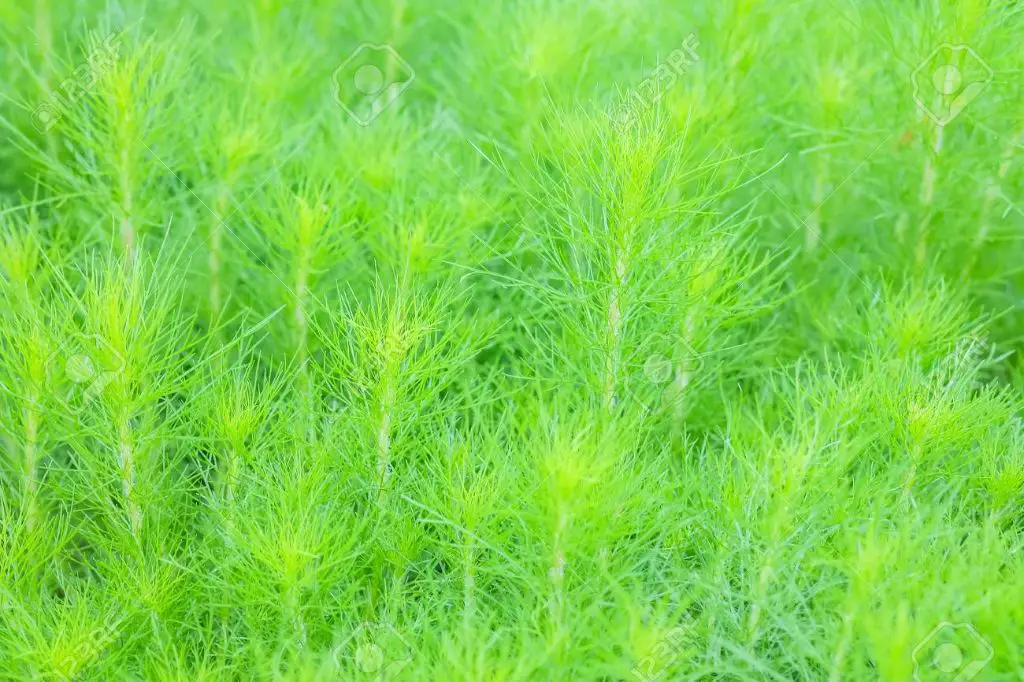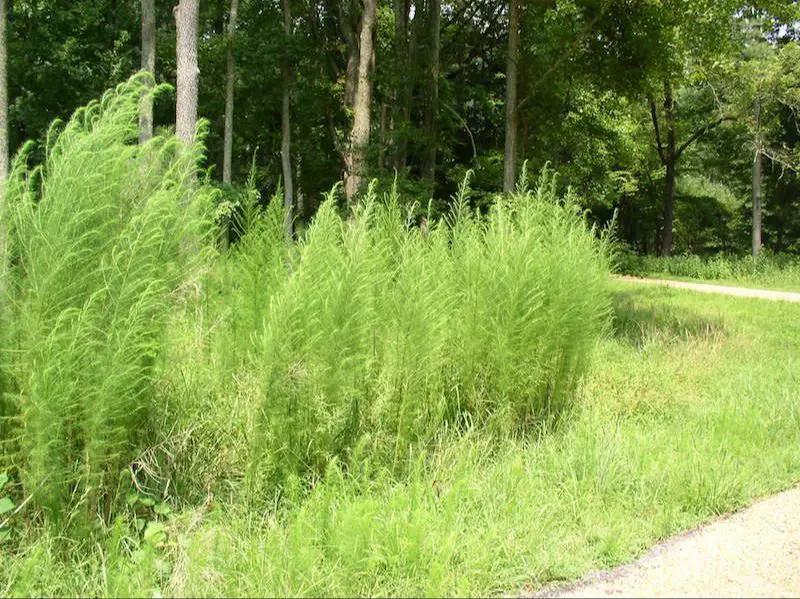What is Dog Fennel?
Dog fennel (Eupatorium capillifolium) is a perennial herbaceous plant in the Asteraceae (daisy) family. It has several common names including dogfennel, eastern dogfennel, and eupatorium. The stems of dog fennel grow up to 5 feet tall and cluster together, bearing green narrow leaves that resemble dill. Tiny yellow flower clusters bloom at the tops of the stems in late summer through fall. The fern-like foliage and floral clusters give dog fennel a unique, lacy appearance. When crushed, the leaves have a pungent, aromatic odor. Dog fennel is identifiable by its tall stature, finely divided leaves, and yellow flower heads which resemble other Eupatorium species in the aster family.
Description of the Plant
Dog fennel (Eupatorium capillifolium) is a herbaceous perennial plant that is part of the Asteraceae family. It has finely divided foliage that looks similar to dill or fennel, hence the common name dog fennel. The plant grows upright to a height of 3-6 feet tall.

The leaves of dog fennel are very thin and threadlike, growing 2-5 inches long. The leaves are arranged alternately along the upright stem and are divided into many small segments. The leaves have a green color on top and a whitish hue underneath.
Dog fennel produces many small flower heads at the ends of the stems and branches. The flowers are creamy white and bloom in late summer through fall. The flowers are grouped together in corymbs 2-4 inches wide. Each flower head contains around 20 small florets. The blooms attract butterflies and other pollinators.
Native Range and Habitat
Dog fennel is native to the southeastern United States and some Midwestern states. It originated in northern Florida and coastal areas along the Gulf of Mexico. Dog fennel grows abundantly throughout the southeast, especially in Florida, Alabama, Mississippi, Louisiana, Texas, and parts of Arkansas.
This herbaceous plant thrives in warm temperate climates with long growing seasons. It occurs naturally in a variety of habitats including pine forests, scrublands, coastal areas, disturbed sites, pastures, and roadsides. Dog fennel prefers sandy, acidic soils that are well-drained and receive plenty of sunlight.
Dog fennel occurs in areas with mild winters and hot, humid summers. It can tolerate summer heat and drought well once established. The natural range reflects regions with average summer high temperatures around 90°F and average winter lows above 30°F.
Uses for Dog Fennel

Dog fennel has had a variety of uses throughout history, both culinary and medicinal. Culturally, the plant has significance in certain regions as well.
Culinary Uses
The leaves, stems, and flowers of dog fennel are edible. The flavor is similar to anise or licorice. Young leaves can be eaten raw in salads or cooked as a potherb. The stems and flowers can be used to flavor drinks or baked goods.
Medicinal Uses
Dog fennel has been used medicinally for digestive issues, coughs, fevers, and gas. Teas and tinctures made from the leaves and flowers have been used as remedies for these ailments. Some herbalists claim it has antimicrobial properties.
Cultural Significance
Dog fennel holds cultural significance in some regions where it grows natively. Native American tribes used it ceremonially and medicinally. The Seminole tribe referred to it as “seni talape” or “old man’s root” and valued it for its medicinal properties.
Growing Conditions
Dog fennel thrives in a variety of conditions, making it relatively easy to grow. Here are some tips on its ideal growing conditions:
Soil – Dog fennel can tolerate most soil types including clay, loam and sandy soils. It prefers slightly acidic to neutral soil with a pH between 6.0-7.0. The soil should have decent drainage to prevent soggy conditions.
Sunlight – Dog fennel grows best in full sun, meaning it should receive at least 6 hours of direct sunlight per day. Partial sunlight is also suitable, but may result in leggier growth.
Water – Newly planted dog fennel requires regular watering until established. Once mature, it is quite drought tolerant but occasional deep watering during dry periods will keep it looking its best. Avoid overwatering as the plant dislikes soggy soil.
Propagation
Dog fennel can be propagated in three ways – through seeding, cuttings, and division.
To propagate from seed, allow the plant’s flowers to go to seed in late summer. The flowers will develop into brown seed heads containing many tiny seeds. You can collect the dried seed heads and remove the seeds. Sow the seeds directly outdoors in fall, or start them indoors 4-6 weeks before the last expected frost. Barely cover the seeds with soil. Germination rates are often low, but you may get new seedlings sprouting the following spring.

For cuttings, take 4-6 inch stems from an established plant in spring or early summer. Remove the lower leaves and place the cuttings in pots with potting mix. Keep them in bright, indirect light and water sparingly until new growth emerges in a few weeks.
You can also divide mature dog fennel clumps in spring or fall. Use a shovel to lift and divide large root balls into smaller sections. Replant the divisions and water well until established.
Pests and Diseases
Dog fennel is relatively free from serious pest and disease issues. However, there are a few potential problems to watch out for:
Aphids – These small, sap-sucking insects can sometimes infest dog fennel plants. Look for clusters of them on stems and undersides of leaves. Try spraying off with water or use insecticidal soap.
Whiteflies – Similar to aphids, these tiny white bugs feed on plant sap. Check the undersides of leaves for whiteflies or their sticky excrement. Use yellow sticky traps or neem oil treatments.
Leaf spot fungus – This fungal disease causes round brown spots on leaves. It thrives in wet conditions. Improve air circulation and avoid overhead watering. Remove and destroy affected foliage.
Rust – Rust fungus causes powdery orange/brown spots on leaves and stems. Prune infected parts and apply a fungicide. Promote air flow between plants.
Practice good sanitation by removing fallen leaves and debris around dog fennel plants. Ensure proper spacing for airflow. Scout regularly for signs of infestation and treat promptly. Maintain overall plant health through proper watering, fertilization and pest monitoring.
Caring for Dog Fennel

Growing healthy dog fennel plants requires knowing the proper care and maintenance practices. Proper care includes occasional pruning, fertilizing at the right times, and overwintering the plant in climates with cold winters.
Pruning dog fennel every few years helps keep the plant tidy and prevents gangly, overgrown specimens. Trimming off old flower heads after blooming also encourages more new flowers. Cutting the plant back by about a third in early spring removes any frost-damaged parts and shapes the plant.
Fertilizing dog fennel once in the spring and again in mid-summer provides nutrients needed for growth and flowering. Use a balanced organic granular fertilizer scratched into the soil around each plant. Take care not to over-fertilize, as excessive nutrients can cause floppy, weak growth.
In zones with cold winters, dog fennel dies back to the ground after hard frosts. Cut plants to the ground in fall once frosted or when they look unsightly. Apply a layer of mulch over the roots to insulate them through winter. The plants will sprout back up from the roots when warm weather returns in spring.
Benefits of Dog Fennel
Dog fennel offers a few key benefits that make it an interesting plant to grow in certain contexts:
Ecological Benefits
From an ecological perspective, dog fennel provides food and habitat for certain wildlife species. The flowers attract an array of pollinators like bees, butterflies, and beneficial insects. Birds and small mammals may also forage on the seeds. As a hardy wildflower, dog fennel can help populate neglected areas and prevent soil erosion.
Culinary Uses
While not as popular as other herbs, dog fennel does have some culinary applications. The edible flowers can provide a light anise-like flavor to salads or as a garnish. The leaves and stems may also be used for teas, imparting a subtle licorice taste. However, dog fennel should be consumed in moderation due to the toxicity concerns mentioned earlier.
Herbal Medicine
Various parts of the dog fennel plant have been used in herbal medicine contexts. Tea made from the leaves has traditionally been used as a digestive aid or laxative. Topically, the plant may help relieve minor skin irritations when applied as a poultice or salve. However, these applications require caution and research due to the potential toxicity of dog fennel’s organic compounds.
Potential Drawbacks
While dog fennel offers some benefits, there are a couple potential drawbacks to be aware of if you are considering growing this plant.
One issue to watch out for is that dog fennel can become invasive in certain areas. This plant spreads readily via seeds and root sprouts. If left unchecked, it may crowd out desirable plants and take over spaces where it is not wanted.
Dog fennel also contains compounds called thujones that can be toxic, especially to livestock. Thujones can cause neurological issues and muscle spasms if consumed in large quantities. While human poisoning is rare, caution is advised. Keep dog fennel away from grazing animals.
With some care and maintenance, the benefits of dog fennel can be enjoyed without the drawbacks. But being aware of its potential to spread invasively and its toxicity is important.